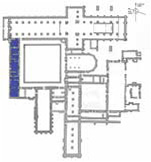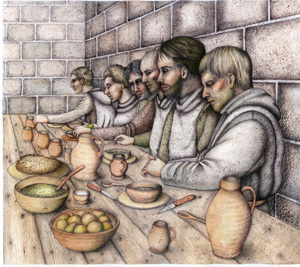 |
 |
 |
 |
 |
 |
 |
|
The western range
The western range at Rievaulx dates from the 1130s and is thus one of the oldest if not the oldest stone buildings within the precinct. In fact, it is really the only of Abbot William’s buildings with substantial remains. This rather simple and plain building was primarily used by those lay-brothers who worked and lived at the abbey rather than on the granges. Here they had their own refectory, dormitory and toilet-block (reredorters). In a Benedictine house, where there were no lay-brothers, the western range was occupied by the cellarer and generally also had accommodation for guests. Like most of the other buildings the western range at Rievaulx was remodelled on several occasions, which means that it is now difficult to establish just how it looked in the twelfth century. Remains of the original outer parlour show that this initially occupied the northernmost bay of the range, which adjoined the church. Here merchants might conduct business, the monks could speak with any family and friends who visited, and access to the inner court, the church and cloister was controlled. The area next to this (bays 2-5) was used as cellarage to store grains, salted foods and other provisions, as well as hides and wool that were to be taken to market or sold to merchants. In the twelfth century a door connected the cellar to a room that was perhaps occupied by the cellarer, an important monastic official who was responsible for the community’s provisions. This was later reconstructed to accommodate a new and roomier outer parlour and it is likely that the daystairs projected to the west of the parlour entrance.(1) The remainder of the ground-floor accommodated the lay-brothers’ refectory. The tables would have been arranged around the walls and, like the monks, the lay-brothers would have sat facing inwards. There was no reading during the lay-brothers’ meals and consequently there was no pulpitum in their refectory. Nevertheless, the lay-brothers were to remain silent while eating and to observe good table manners. The lay-brothers ate the same food as the monks but generally received larger portions on account of their heavy labour. They were also served a light breakfast, the mixt, which was taken by novices, servers and the infirm. Their food was prepared in the same kitchen as the monks’ and was passed to the refectory through a serving hatch. The lay-brothers at Rievaulx may also have gathered in the refectory for their weekly chapter meeting. The range may have extended further south, but the area here has not been excavated.(2) |
 (1/2)
(1/2)
